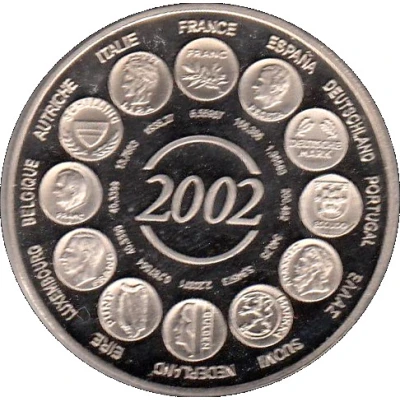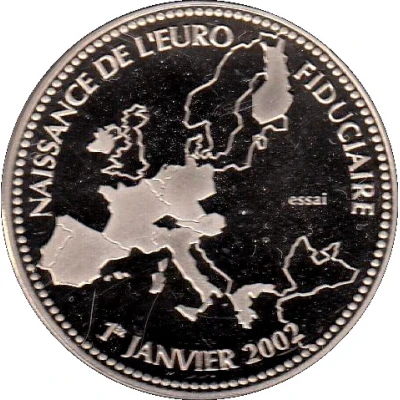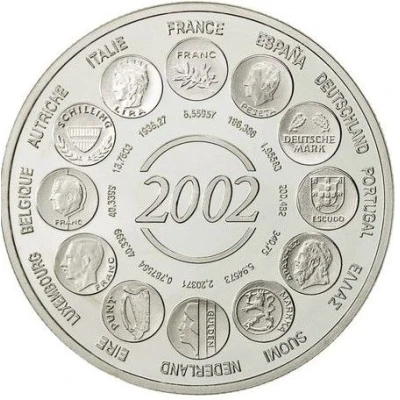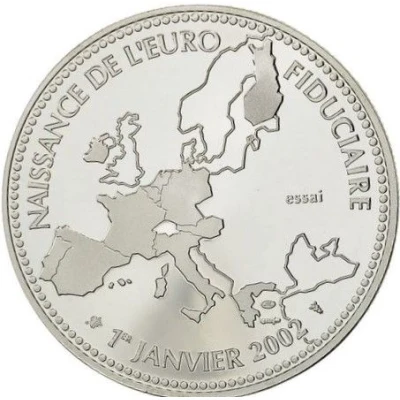


© Ettocad
Medal - Euro introduction
2002 year| Copper-nickel | 31 g | 41 mm |
| Location | France |
|---|---|
| Issuing entity | Société Trésor du Patrimoine - Club Français de la Monnaie |
| Period | Fifth Republic (1958-date) |
| Type | Medals › Commemorative medals |
| Year | 2002 |
| Composition | Copper-nickel |
| Weight | 31 g |
| Diameter | 41 mm |
| Shape | Round |
| Technique | Milled |
| Orientation | Medal alignment ↑↑ |
| Demonetized | Yes |
| Updated | 2024-11-12 |
| Numista | N#21589 |
|---|---|
| Rarity index | 59% |
Reverse
Map of Europe
Lettering:
NAISSANCE DE L'EURO FIDUCIAIRE
essai
1er JANVIER 2002
Engraver: Pierre Rodier
Edge
Milled
Comment
2002 BIRTH OF THE EUROAfter 642 years of existence, the Franc has given way to the Euro. The idea of a single European currency was born in 1992 at Maastricht in the Netherlands, with the signing of the treaty creating the Economic and Monetary Union.
The new currency was officially named "EURO" in December 1995, at the Madrid European Council. This adopted the principle of a new currency and its introduction on January 1, 2002.
A year later, the Amsterdam European Council adopted the Stability and Growth Pact and a new exchange rate mechanism designed to guarantee stability between the Euro and the currencies of non-participating member states. The design of the European sides of the Euro coins was adopted following a competition organized by the European Commission.
In 1998, the European Commission published its convergence report, recommending the participation of 11 European countries in the single currency: Austria, Belgium, Finland, France, Germany, Ireland, Italy, Luxembourg, Netherlands, Portugal and Spain. Greece joined the Eurozone a few months later. The Eurozone and the Schengen area were created, allowing the free movement of people and goods. Great Britain, Denmark and Sweden did not join for two reasons: either they simply refused, or they did not meet the convergence criteria.
On December 31, 1998, the European Council adopted the irrevocable conversion rates between the Euro and the participating currencies. For France, the rate was set at 6.55957 F for 1 euro.
The real birth of the Euro took place on January 1, 1999, and until December 31, 2001, it became the legal currency of the member countries of the Euro Zone, with national currencies remaining mere subdivisions. The European Central Bank was responsible for monetary policy, which was defined and implemented in euros. For the general public and businesses, the Euro came into effect on January 1, 2002.
Cashless money in francs was banned, and dual display became compulsory until at least June 30, 2002. On February 17, 2002, the Franc officially disappeared and the Euro became the compulsory currency for all French citizens.
Source: Trésor du patrimoine
Price
| Date | Mintage | VG | F | VF | XF | AU | UNC |
|---|---|---|---|---|---|---|---|
| 2002 | 100000 | - | - | - | - | - | - |
Values in the table are based on evaluations by sales realized on Internet platforms. They serve as an indication only for Medal - Euro introduction 2002 item.



